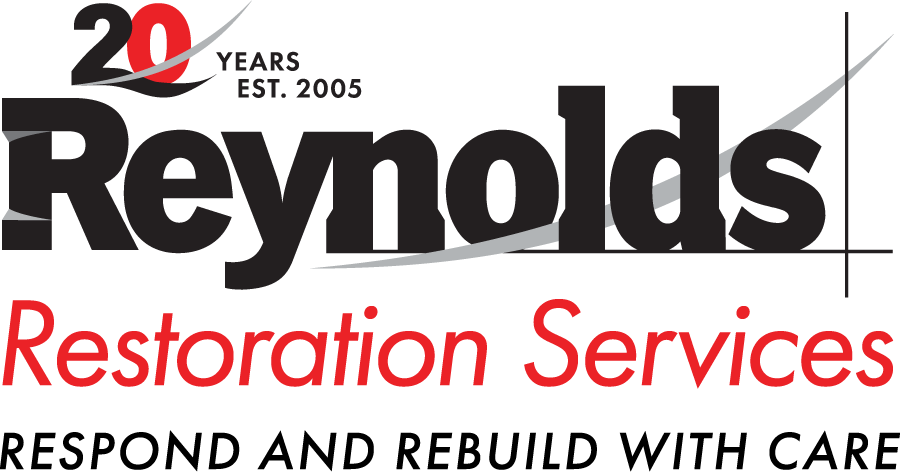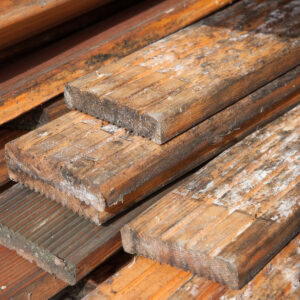Wood surfaces are ideal locations for mold growth, especially when they are in a damp, warm environment such as an attic or basement. Mold thrives on wood surfaces such as ceiling beams, joists, windowsills, trim, and even furniture. Knowing how to remove mold on wood can help you minimize health risks for home occupants and structural damage to your home.
Removing mold by yourself can pose some risk, however with proper safety measures, you can remove mold on wood in a few easy steps. Let’s take a look at how to identify mold growth on wood and the steps to remove it.
How to Identify Mold on Wood
Before diving into any mold removal steps, it’s important to learn how to identify mold on wood. Some discoloration on wood may not actually be mold. The discoloration could be caused by sun exposure, naturally occurring enzymes, minerals, fasteners such as nails or screws, or even natural changes in the wood as it ages.
How do you know if there is mold on wood? Here are several ways to identify mold growing on a wood surface:
- Damp Environment: Mold needs three things to thrive – a food source (in this case, wood), oxygen, and moisture. If there is moisture present and you suspect you have a mold issue, you are likely correct. Leaking attics and damp basements are ideal places for mold to take hold and spread.
- Presence of Mold Spores: While this may seem obvious, some homeowners miss this vital clue there is mold growing on wood. Depending on the type of mold, mold spores are visible and can be black, white, green, orange, and even purple. Some homeowners mistake mold spores for dust, dirt, or other debris, especially if the wood is in an unfinished area like a basement or attic.
- Damaged Wood: Given enough time, mold can start to damage and deteriorate wood surfaces. Mold will devour the nutrients on a wood surface and the wood may begin to warp and buckle.
While discovering mold in your home can be overwhelming, mold-infested wood can be salvaged in a few easy steps. As a word of caution – mold can be toxic and cause health issues. For large mold issues, it may make sense to have a professional mold remediation company tackle the problem for you.
Steps to Remove Mold on Wood
If you’ve discovered mold on wood in your home, speed is key to not only remove it, but also keep it from spreading throughout your entire home. When mold spores hit your HVAC system, they can travel to other areas of the home and cause extensive problems. Here are basic steps to remove mold from wood surfaces:
- Wear Proper Safety Gear: First and foremost, put on proper safety gear before you start the mold removal process. Mold spores can cause health issues such as sneezing, coughing, and itchy or watery eyes. Always wear a mask, goggles, and gloves when removing mold from wood.
- Vacuum Area: Using a vacuum with a HEPA filter, vacuum the area to remove loose mold spores, dust, and dirt. After you are done, carry the vacuum outside to empty it. If you empty the canister inside your home, you will release the mold spores back into the air. Professional mold remediation companies have vacuums specifically designed to safely remove mold spores.
- Clean Area: Once you’ve vacuumed the area, it’s time to clean the wood surface to remove the mold that has grown on its surface. There are several different products and cleaning solutions you can use to clean mold from wood including basic soap and water, bleach, distilled white vinegar, hydrogen peroxide, baking soda, and Borax. When using a solution to remove mold, spray it onto the surface and gently scrub the area with a soft-bristled brush. Stubborn mold stains may require you to repeat the process several times. Once the mold is removed, allow the area to dry completely.
- Sand Wood Surface: When mold has penetrated the wood, you may have to take one additional step to remove it – sanding the wood surface. Sanding may be the only way to reach mold that has gone below the surface of the wood, especially in wooden furniture and wood floors. Black mold can especially be tough to remove without sanding.
Even after going through the mold removal steps, you may still find you have mold damage and need professional mold remediation services. At Reynolds Restoration Services, our team of mold remediation specialists can tackle your mold issue quickly and safely.
Learn About Our Mold Removal Services
Professional Mold Remediation from Reynolds Restoration Services
Reynolds Restoration Services has been helping home and business owners tackle tough mold issues for more than 15 years in the Harrisburg, Pa., Philadelphia, Pa., and Baltimore, Md./DC regions. Our team goes through the proper training for mold removal and remediation and has the tools and resources to do it safely, quickly, and efficiently.
Our mold removal process includes:
- Wipe/sanitize all surfaces with a non-toxic EPA approved mold removal solution
- Clean mold affected surfaces with a HEPA vacuum. HEPA vacs are different from household machines and have filters specifically designed to trap mold spores.
- “Scrub” the air to remove additional mold spores. This step helps to trap airborne mold spores that may settle after mold has been removed from surfaces. We scrub the air using a special machine – an air scrubber – that is generally not something a homeowner has on hand.
- If necessary, remove damaged wood and other materials that are beyond repair.
DIY mold removal can be dangerous, so reach out today to Reynolds Restoration Services for help. We are on-call 24/7 and can be to your home within hours of your call.

President of Reynolds Restoration Services. Over 20 years of experience in the emergency restoration industry.


